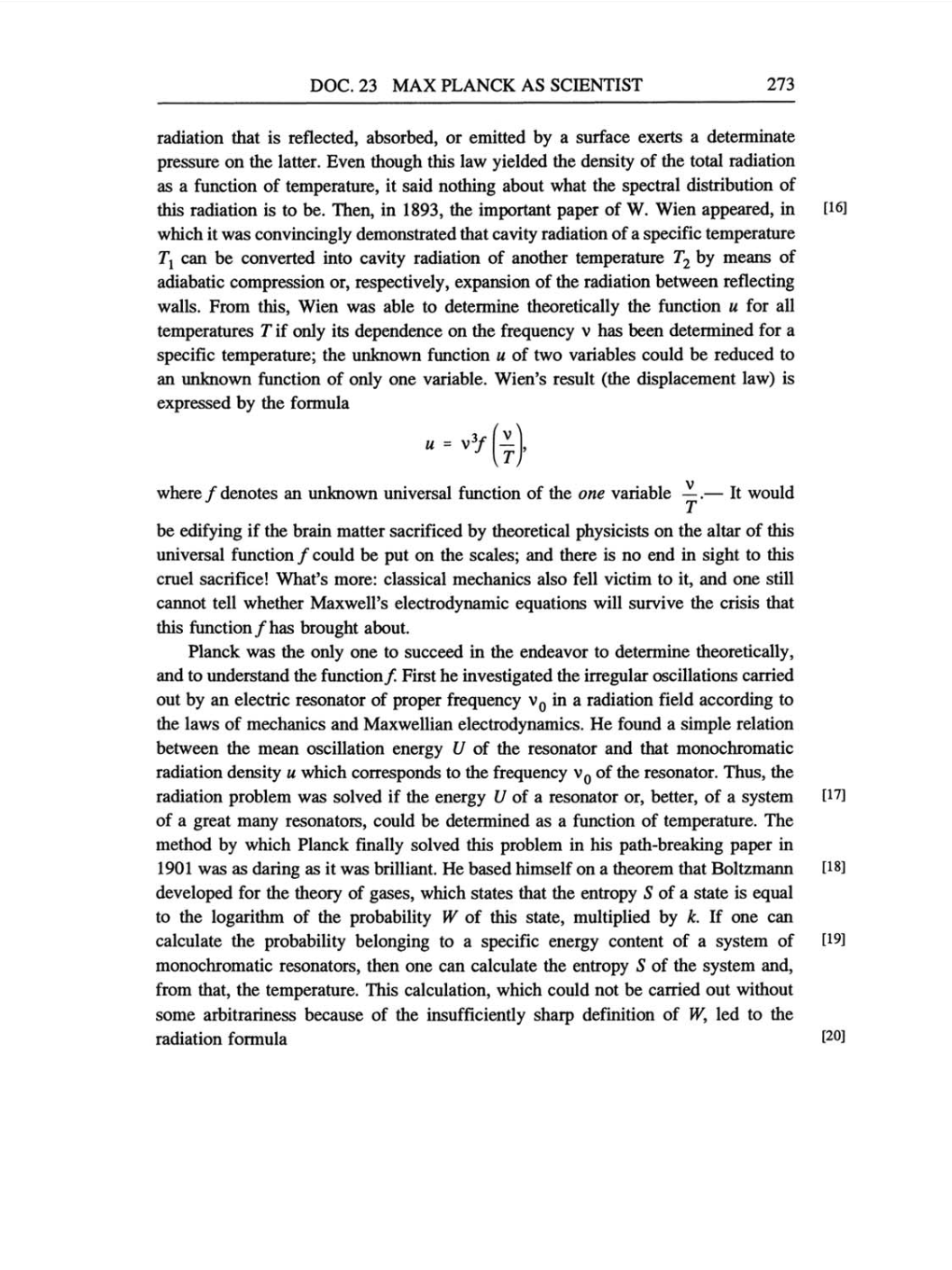DOC.
23
MAX PLANCK
AS
SCIENTIST 273
radiation that is
reflected, absorbed,
or
emitted
by
a
surface exerts
a
determinate
pressure
on
the latter. Even
though
this
law
yielded
the
density
of
the total radiation
as a
function
of
temperature,
it said
nothing
about what the
spectral
distribution of
this radiation
is to
be.
Then,
in
1893,
the
important paper
of
W.
Wien
appeared,
in
[16]
which it
was
convincingly
demonstrated
that
cavity
radiation of
a
specific temperature
T1
can
be converted into
cavity
radiation
of
another
temperature
T2
by
means
of
adiabatic
compression or, respectively, expansion
of
the
radiation
between
reflecting
walls. From
this,
Wien
was
able
to
determine
theoretically
the function
u
for all
temperatures
T if
only
its
dependence on
the
frequency v
has been determined for
a
specific temperature;
the unknown function
u
of
two
variables could be reduced
to
an
unknown function
of
only
one
variable. Wien's result
(the
displacement
law)
is
expressed by
the formula
u
=
v3f(v/T),
where
f
denotes
an
unknown
universal function
of the
one
variable
v/T.-
It would
be
edifying
if
the brain
matter
sacrificed
by
theoretical
physicists
on
the altar of this
universal
function
f
could be
put
on
the
scales;
and there is
no
end in
sight
to
this
cruel sacrifice! What's
more:
classical mechanics also fell victim
to
it,
and
one
still
cannot
tell whether Maxwell's
electrodynamic equations
will survive the crisis that
this
function f
has
brought
about.
Planck
was
the
only
one
to
succeed in the endeavor
to
determine
theoretically,
and
to
understand the
function
f.
First he
investigated
the
irregular
oscillations carried
out
by an
electric
resonator of
proper frequency
v0
in
a
radiation field
according
to
the laws of mechanics and Maxwellian
electrodynamics.
He found
a
simple
relation
between the
mean
oscillation
energy
U
of the
resonator
and that monochromatic
radiation
density
u
which
corresponds
to
the
frequency
v0
of the
resonator. Thus,
the
radiation
problem was
solved if the
energy
U of
a
resonator
or,
better,
of
a
system
[17]
of
a
great many resonators,
could be determined
as a
function of
temperature.
The
method
by
which Planck
finally
solved this
problem
in his
path-breaking paper
in
1901
was as
daring
as
it
was
brilliant. He based himself
on a
theorem that Boltzmann
[18]
developed
for the
theory
of
gases,
which
states
that the
entropy
S
of
a
state is
equal
to
the
logarithm
of
the
probability
W
of this
state,
multiplied by k.
If
one
can
calculate the
probability belonging
to
a specific energy
content
of
a
system
of
[19]
monochromatic
resonators,
then
one can
calculate
the
entropy
S
of the
system and,
from
that,
the
temperature.
This
calculation,
which could
not
be carried
out
without
some
arbitrariness because
of
the
insufficiently sharp
definition of
W,
led
to
the
radiation formula
[20]
